NRAO eNews
Volume Vol#, Issue Iss#
Day# Month# Year#
NRAO eNews
Volume Vol#, Issue Iss# • Day# Month# Year#

Upcoming Events

8th VLA Data Reduction Workshop
Mar 15 - Apr 1, 2021 | Virtual

The Past, Present, and Future of the VLA: Celebrating 40 Years
Aug 4 - 7, 2021 | Virtual
ALMA Ambassadors Proposal Preparation Events
In advance of the ALMA Cycle 8 2021 Call for Proposals deadline, the North American ALMA Science Center (NAASC), along with current ALMA Ambassadors, have organized a series of online ALMA proposal preparation webinars and hands-on sessions from 22 March - 02 April 2021. The goal of these events is to provide users with the knowledge they need to carry out cutting-edge scientific research using the ALMA facilities. We are particularly interested in reaching new users, so no experience with radio astronomy is required to participate!
These ALMA talks are hosted by experienced postdocs as part of the ALMA Ambassadors program. Registration for these events is free and each talk will be given multiple times to accommodate the diverse schedule constraints of the community. Talks are designed to assist you in proposal preparation and observation planning for ALMA Cycle 8 2021, and will be given on the following topics:
- ALMA Basics and Cycle 8 2021 Capabilities
- Radio Interferometry Basics
- The Cycle 8 2021 Proposal Review Process
- Introduction to the ALMA Observing Tool (includes a hands-on component)
- ALMA Data Products, Archive Use, and Notes on the Pipeline Weblog
- What's new in CASA
- CASA Simulations (includes a hands-on component)
- Science-ready Data Products (includes a demo)
- Imaging with CASA
Talks will be given from 22 March - 02 April 2021. A selection of talks will be given in Spanish, as noted on the schedule.
The schedule of events and registration links for the talks are online.
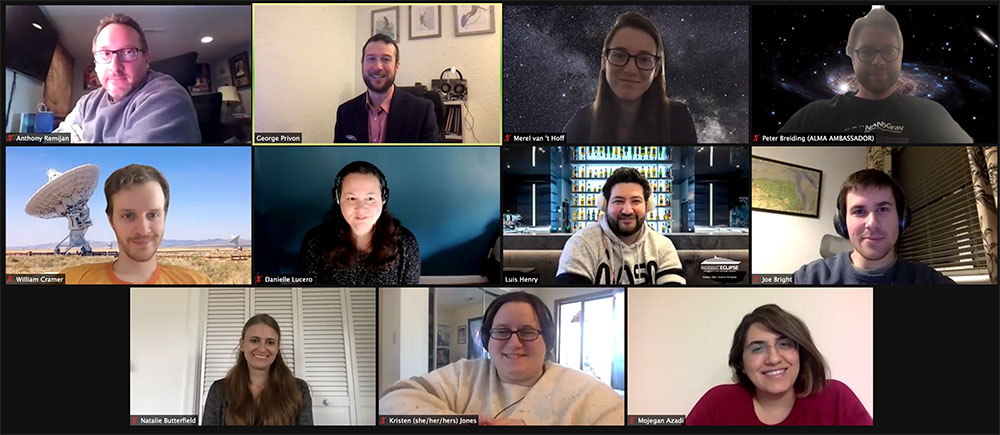
The 2021 ALMA Ambassadors [left to right, top to bottom]: Anthony Remijan (NRAO - North American ARC Manager), George Privon, Merel van 't Hoff (Michigan), Peter Breiding (West Virginia), William Cramer (Arizona State), Danielle Lucero (Virginia Tech), Luis Henry Quiroga-Nuñez (NRAO & New Mexico), Joe Bright (Northwestern), Natalie Butterfield (Green Bank Observatory), Kristen Jones (Kansas), Mojegan Azadi (Harvard & Smithsonian | Center for Astrophysics). The other ambassadors are David Rebolledo (ALMA) and Alexander Thelen (NASA Goddard).
[click to enlarge]
ALMA Program News
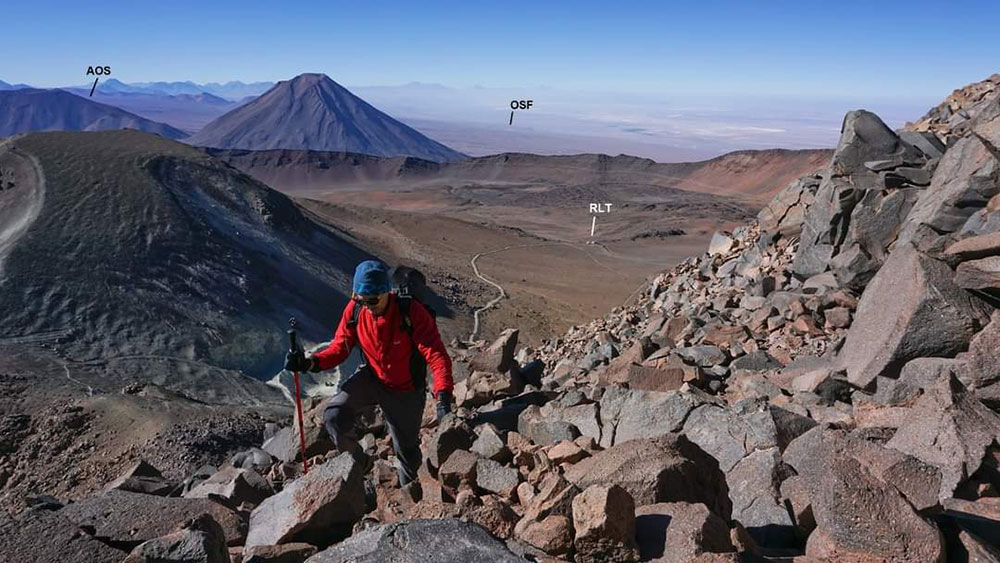
Pablo Carrillo
The ALMA Observatory from Sairecabur Volcano (elevation 5970m): ALMA Director Sean Dougherty, the Array Operation Site (AOS, 5000m) on the Chajnantor plateau, the Operations Support Facility (OSF, 2900m), and a predecessor observatory, the Harvard-Smithsonian Receiver Lab Telescope (RLT) in the Volcano crater (5500m).
[click to enlarge]
ALMA Science Sustainability
The Cycle 9 Call for North American (NA) Development Project Proposals was announced 15 January 2021. An Informational Meeting was held 16 February, for which presentations are available and questions asked appear on the FAQ page. Notices of Intent were required before 1 March 2021. The deadline for receiving the proposals will be 9 April 2021. Project execution can only begin after adjudication at the November 2021 ALMA Board Meeting. See NADevelopmentProgram
Joint ALMA Observatory Return to Operations Status
The planned February Shutdown wrapped up successfully. Progress continues for ALMA's return to operations, resuming the Cycle 7 observing program later this month, March 2021.
ALMA Cycle 8 2021 Pre-Announcement
Following the postponement of original planning for Cycle 8 because of the COVID-19 pandemic, the Joint ALMA Observatory (JAO) will now start the next cycle of observations, referred to as "Cycle 8 2021", in October 2021. A Call for Proposals with detailed information on Cycle 8 2021 is anticipated to be issued 17 March 2021 and the deadline for proposal submission will be 21 April 2021.
The ALMA 2030 Vision: A Next Generation of Front-end Receivers
The vision for ALMA's future development is described in the ALMA Development Roadmap. To implement this vision, a series of three workshops has been envisioned, in conjunction with corresponding working groups defining the appropriate scientific and technical specifications. Following the first two workshops held in 2020 to discuss potential correlator upgrades and digitizer upgrades that will realize the ALMA 2030 vision, we plan to complete the workshop trilogy with an ALMA Front-End Development Workshop, entitled The ALMA 2030 Vision: A Next Generation of Front-end Receivers. This workshop will be held online, in the week of 27-30 September 2021.
This workshop is intended to be relatively small and focused, but we explicitly welcome participation from all ALMA regions and the rest of the world. Registration and abstract submission will open at the end of March. Please distribute this message to interested colleagues and within your institutes as appropriate. Further information will be included in the 2nd announcement, and will also be made available on the meeting website.
The website is under construction, and registration will open later in March.
ngVLA Project News

ngVLA Antenna Prototype
Proposals for the final design and prototype of the ngVLA 18m antenna were submitted by vendors in December. The ngVLA Project has selected the winning proposal. A formal announcement is imminent.
ngVLA Websites in Japan
Congratulations to our Japanese colleagues, who have launched an ngVLA website in Japanese for the general public, plus a website in English for researchers that showcases 28 memos from Japan's Science Working Groups.
Recent ngVLA Hires
Recent hires by the ngVLA Project include Dr. Eric Jimenez-Andrade, who will start in August as a Research Associate; Mr. Joseph Carilli, who started in January as a Geographic Information Systems Technician; and Mr. Thomas Kusel, who started in October as a System Engineer.
ngVLA Virtual Tour
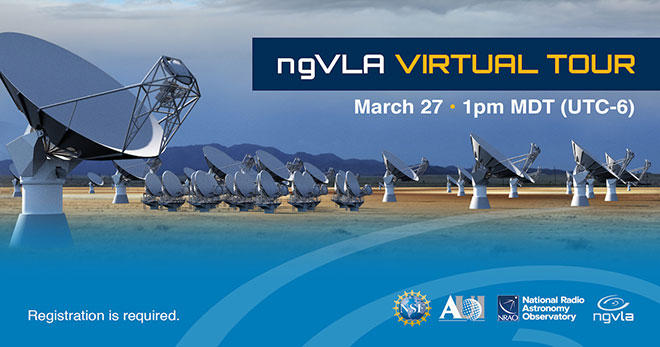
Though the Very Large Array is proud to be celebrating its 40th anniversary, we are also looking toward the future! Our plans for a successor to the VLA, aka the next generation Very Large Array (ngVLA), would result in a new-and-improved telescope capable of taking radio astronomy observations to a new level, opening vast new discovery space.
Join us for a virtual tour to learn more about our current plans for the ngVLA. Further details to come!
This virtual tour will take place on Saturday, 27 March 2021, 1-2 p.m. Mountain Daylight Time (UTC -6).
Registration via zoom is required. More info is available online.
The Ultra-faint Radio Population and ngVLA Prospects
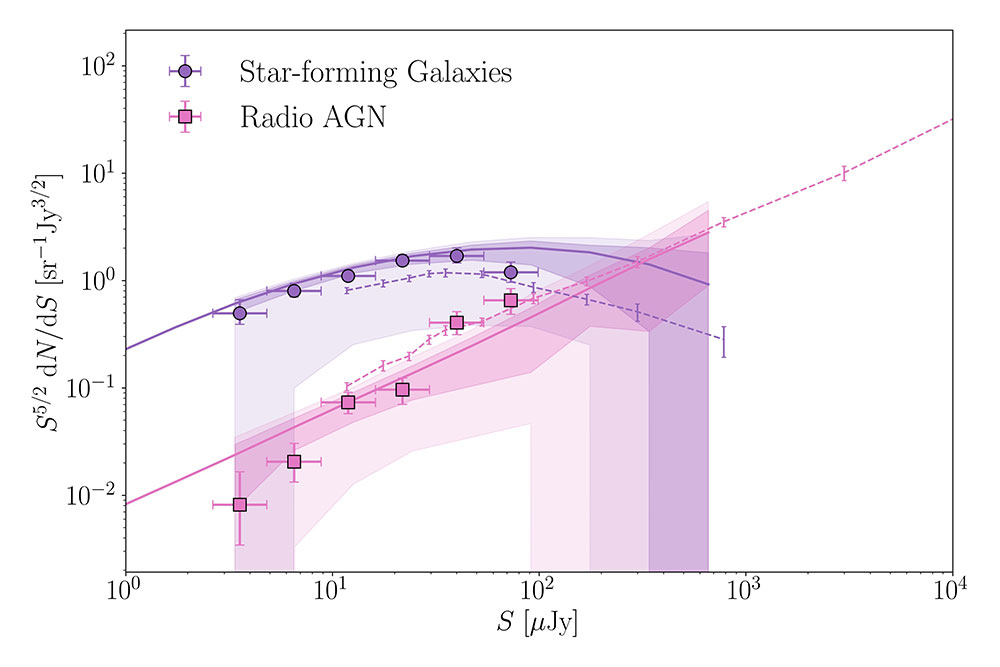
credit
Three GHz radio number counts from the COSMOS-XS survey. Dashed lines show prior observations (Smolcic et al. 2017). Solid lines show simulations (Bonaldi et al. 2019). The COSMOS-XS survey clearly highlights that star-forming galaxies make up the bulk of the microjansky radio sky (adapted from Algera et al. 2020).
[click to enlarge]
Deep radio surveys offer an invaluable view on the evolution of galaxies through cosmic time, as they are sensitive to both recent star-formation activity and emission from active galactic nuclei (AGN). Historically, radio surveys have mostly been limited to probing the latter, as AGN make up the bulk of the bright radio sky (e.g., Condon 1989). However, current radio surveys are capable of routinely probing the sub-mJy radio population, which at GHz frequencies is believed to be comprised predominantly of star-forming galaxies (Smolcic et al. 2017, Bonaldi et al. 2019).
With the ngVLA on the horizon and radio surveys becoming increasingly more sensitive in the meantime, it is of considerable interest to explore the “ultra-faint” radio sky with the current VLA. However, in practice identifying whether radio emission emanates from star-formation or from an AGN is a challenging task which requires sensitive observations at both radio and shorter wavelengths.
In Algera et al. (2020) we investigate the composition of the faint radio population detected in the sensitive COSMOS-XS survey. This survey, described in detail in Van der Vlugt et al. (2021), comprises two VLA pointings at 3 and 10 GHz of sub-microjansky depth, targeting the well-studied COSMOS field. We classify the more than 1500 sources detected at 3 GHz as either star-forming or AGN, based on a comparison of their radio and infrared emission.
The figure shows the 3 GHz radio source counts — that is, the number density of radio sources as a function of flux density with the typical Euclidean normalization — for star-forming galaxies and AGN separately. While both populations are approximately equally numerous at ~100 μJy, the fainter flux densities are overwhelmingly populated by star-forming galaxies. Indeed, below ~20 μJy at 3 GHz, over 90% of the radio sky is powered by star-formation.
The ngVLA is set to revolutionize studies of the faint radio population: while the COSMOS-XS survey makes use of 200 hours of VLA time, the ngVLA will reach a similar depth at 3 GHz in just one hour, opening up a new window of deep, wide-area surveys. In addition, we extrapolate from our results that at flux densities below 1 μJy that AGN make up < 1% of the faint radio sky. As such, future ngVLA surveys will provide large and highly reliable samples of star-forming galaxies, enabling a clear and complete view of cosmic star formation.
Since 2015 the acronym ngVLA has appeared in 650+ publications indexed in the SAO/NASA Astrophysics Data System. This article continues a regular feature intended to highlight some of those publications. We are especially interested in showcasing work done by early-career researchers. Anyone wishing to volunteer to author a feature should contact Joan Wrobel.
The Past, Present, and Future of the VLA: Celebrating 40 Years

On 4 – 6 August 2021, the NRAO will convene a workshop to celebrate 40 years of science from the Very Large Array (VLA), followed by a public event on 7 August. The workshop will highlight the numerous scientific accomplishments of the VLA, past and present, and provide an outlook for the future. The science meeting will be held virtually with presentation times centered around Mountain Daylight Time. Registration and abstract submission for contributed live and pre-recorded presentations will open on 11 March. Please visit the conference website for details.
A Search for VLA Stories
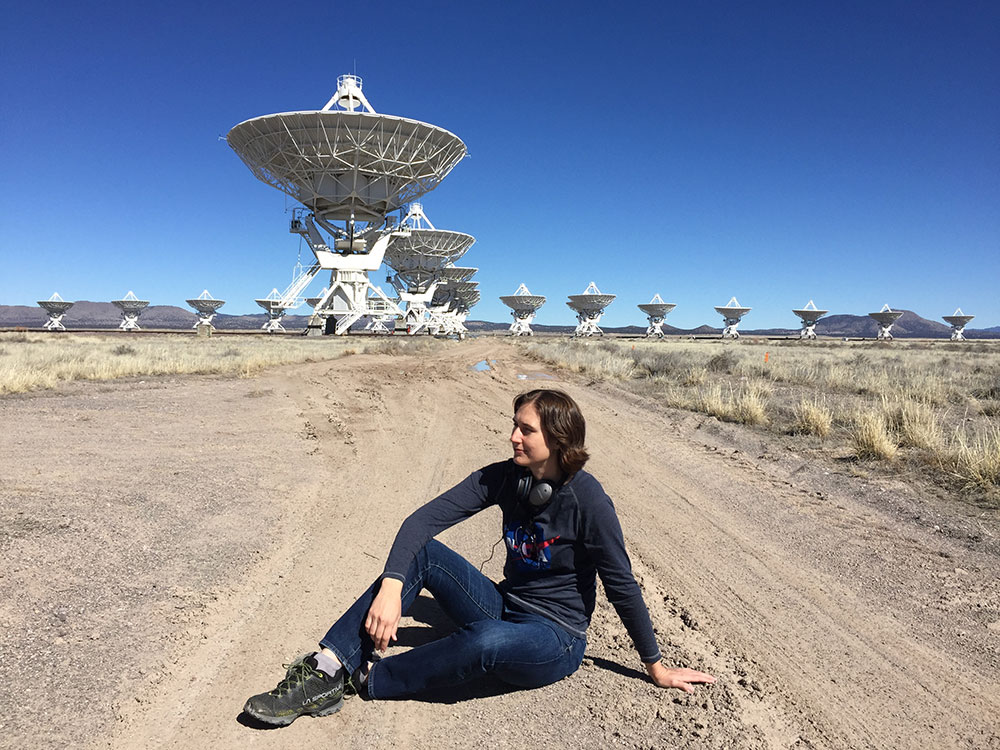
Katie Mack as "Ellie Arroway"
[click to enlarge]
October 10, 2020 marked the 40th Anniversary of the Very Large Array in New Mexico, commemorating one of the most productive ground-based radio telescopes in the world. To celebrate, NRAO’s Education and Public Outreach department is collecting stories and photos to examine the cultural and scientific influence the telescope had over the last forty years, with stories and photos from the people who made it happen.
Tell us your (VLA) story and/or share your photos. You can browse through our list of question prompts or write what inspires you. Upload a photo with a caption about an observation or discovery you worked on.
Submission information and question prompts can be found by accessing this Google form (gmail account required). If you don't have a gmail account, please email us for other submission options.
Robert L. Brown Outstanding Doctoral Dissertation Award
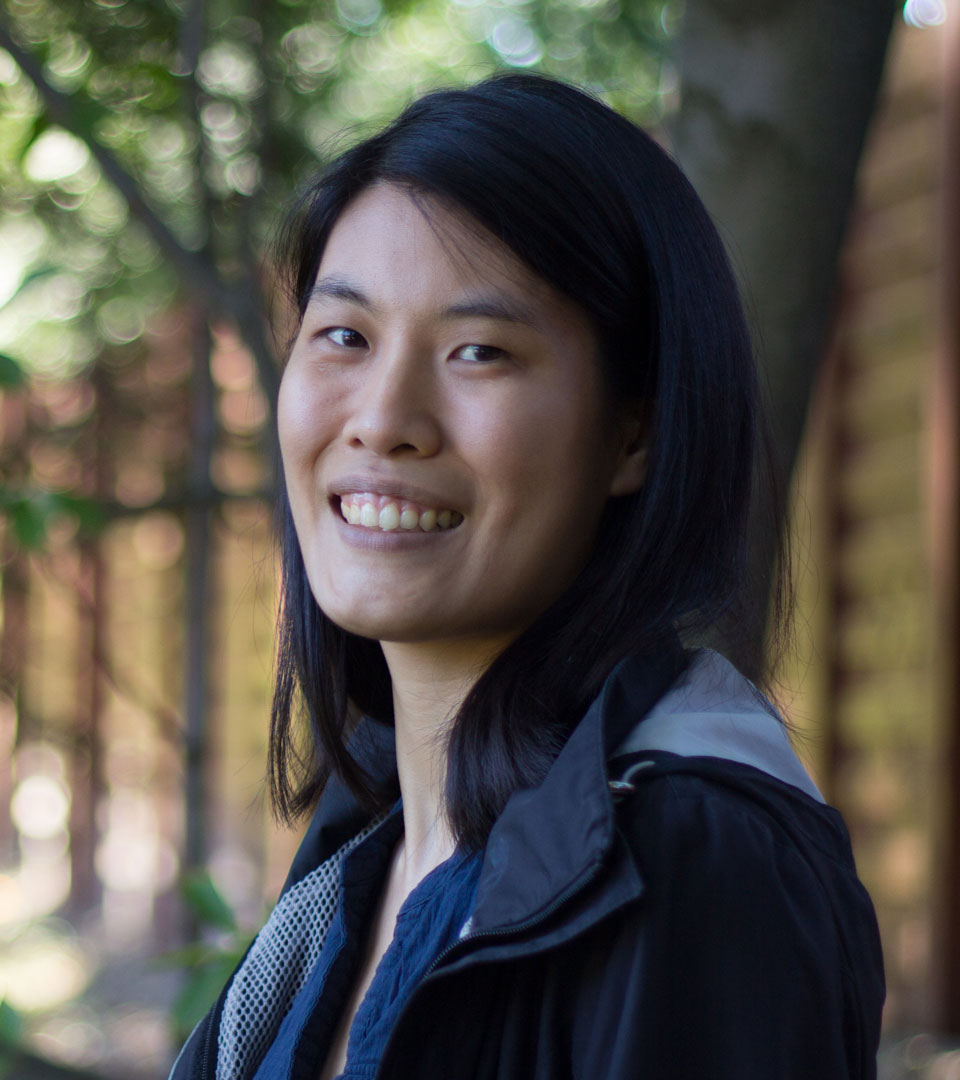
Dr. Jane Huang
[click to enlarge]
NRAO/AUI is pleased to announce that Dr. Jane Huang is the winner of the 2020 Robert L. Brown Outstanding Doctoral Dissertation Award, for her Harvard Dissertation, Rings and Spirals in Protoplanetary Disks: The ALMA View of Planet Formation. Dr. Huang’s work exploited ALMA’s unprecedented detail and sensitivity to trace how planets form from the smallest structures within dense dusty disks around very young stars. Together with her collaborators, she showed that the remarkable radial gas and dust sub-structures within the disks are keys to understanding the formation and chemical composition of young planets. The results of Dr. Huang’s thesis will help to constrain theoretical models of planet formation and will also serve as a scientific pathfinder as new infrared and optical instruments become operational in the next decade. Dr. Huang is currently a NASA Hubble Fellowship Program Sagan Fellow at the University of Michigan. She will receive her award and will present the R. L. Brown Award Lecture at a ceremony to be held later this year.
The Robert L. Brown Outstanding Doctoral Dissertation Award is administered by Associated Universities, Inc. (AUI) and the NRAO on behalf of Bob Brown’s friends and family to honor Bob’s life and career. The Award is given each year to a recent recipient of a doctoral degree from any recognized degree granting institution in the United States, and is substantially based on new observational data obtained at any AUI operated facility and considered to be of an exceptionally high scientific standard value and impact within and beyond the area of study.
The Award is available to degree recipients of any nationality and consists of $1,000, a framed certificate, and an invitation to give a lecture at the NRAO. To be eligible, the applicant must have successfully defended the thesis during the calendar year of the Award.
Applicants should send an e-mail describing their dissertation, the date of their successful thesis defense, the date of the degree award, and the name and contact information of the primary thesis supervisor to RLBrownAward@nrao.edu. A copy of the thesis as a pdf file should be sent by e-mail to the same address or made available via a link given in the email. Published papers or papers in press, or portions thereof, based substantially on the dissertation should accompany the application. Verification of the successful thesis defense and statement that the applicant has successfully completed all university requirements for the Ph.D. should be sent directly by the appropriate university authority to RLBrownAward@nrao.edu. The deadline for receipt of applications and supporting materials for the 2021 Award is 31 December 2021.
Office of Chilean Affairs Move
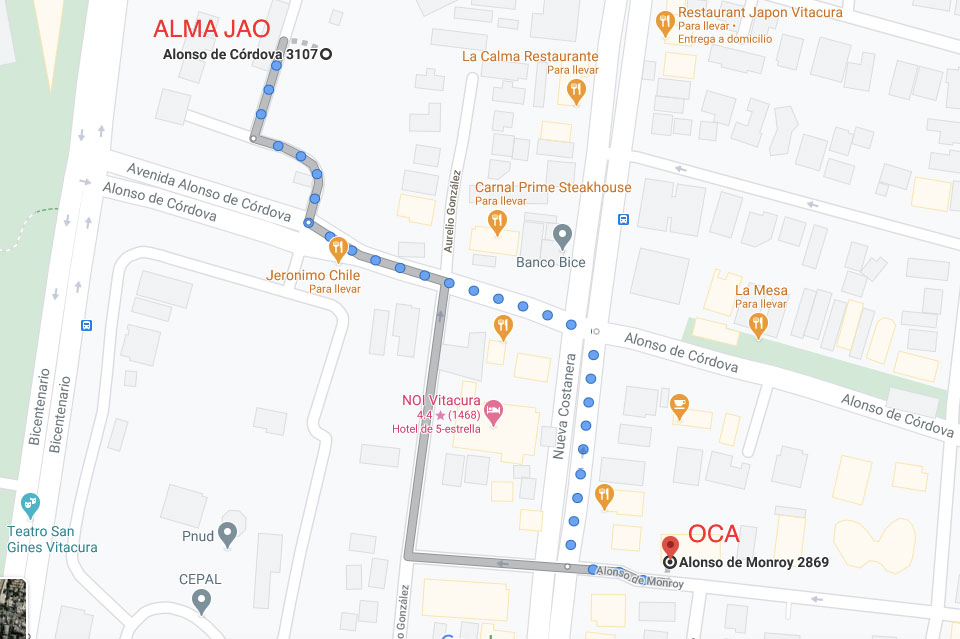
A Google map showing the new OCA office location in Vitacura and the nearby Joint ALMA Observatory offices.
[click to enlarge]
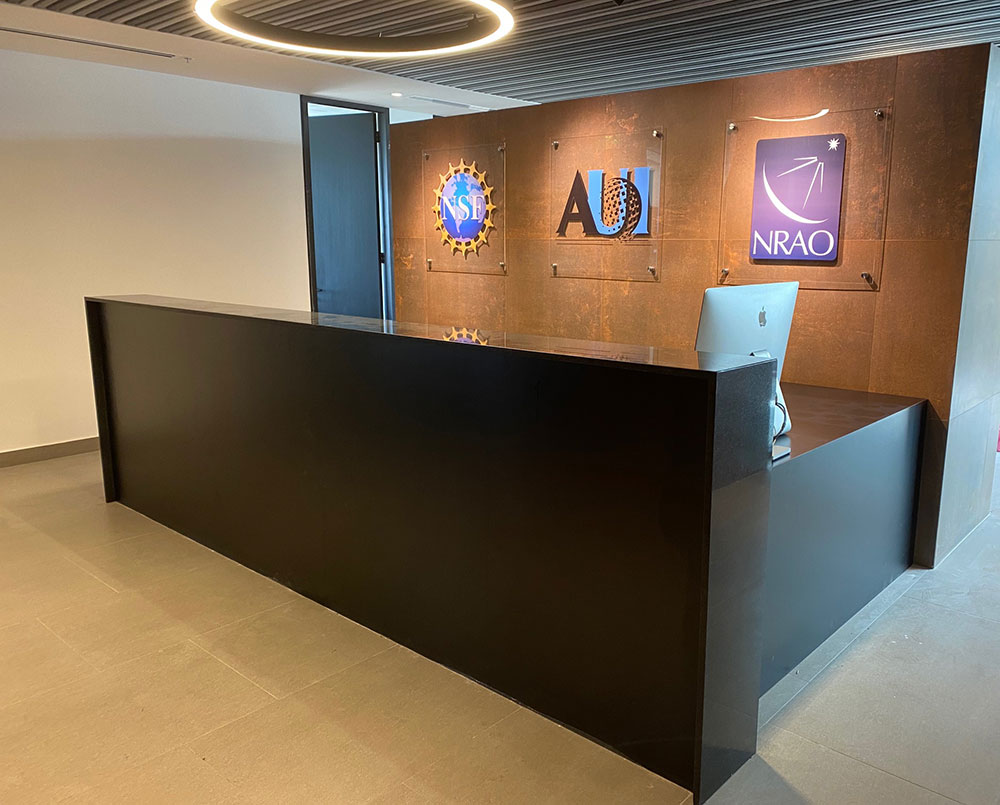
The reception area for the new OCA office.
[click to enlarge]
The Office of Chilean Affairs (OCA) has a new home in Vitacura! As of February, we moved to Av. Alonso de Córdova 2860, Of. 702, a mere two blocks from the Joint ALMA Office in Santiago.
The new location provides additional space for offices and meeting rooms, which will allow us to host local and international visitors, as well as organize education and public outreach activities in our premises. Two adjacent meetings rooms can be joined to accommodate up to 30 participants, an ideal setting for large meetings or Education & Public Outreach activities.
In addition to the meeting rooms, a "work-café" area was set up close to the reception to receive visitors or chat with colleagues in an informal setting. The seventh floor is the top floor in the building, so our offices and common spaces benefit from abundant natural light and a skylight in the kitchen and lunch area. With a maximum occupancy of four staff members per day, we continue to work from home during the pandemic. As soon as we are back in the office, we look forward to welcoming visitors and taking advantage of the new facilities.
Make STEM Better
Now, you can join NRAO in our work to Make STEM Better. Your charitable contribution will directly support under-represented students in learning about astronomy, physics, engineering, technology, and computing, from undergrad to post doc. Gifts to NRAO’s Making STEM Better support student participants in the National Astronomy Consortium and National & International Exchange Program.
Recent Media Releases
|
Most Distant Cosmic Jet Providing Clues About Early Universe |
|
|
VLA Helps Astronomers Make New Discoveries About Star-Shredding Events |
From the Archives
Ellen Bouton

[click to enlarge]
About this month's photo: As part of ALMA site testing, weather balloons, or radiosondes, were launched to measure the vertical profiles of temperature, pressure, and humidity. Balloons were launched about one kilometer west of the present location of the ALMA Array Operations Support building, and the equipment, including the tanks of helium for the balloons, was stored in a container. Inside the container in November 1999 [ Left to right ]: Seichi Sakamoto, Min Yun, Riccardo Giovanelli, Simon Radford, Angel Otarola, Lars Ake Nyman, and Kate Brooks. Thanks to Simon Radford for caption information.
From the Archives is an ongoing series illustrating NRAO and U.S. radio astronomy history via images selected from our collections of individuals' and institutional papers. If readers have images they believe would be of interest to the Archives, please contact Ellen Bouton.

